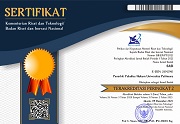Socio-Legal Review of The Implementation of Identification and Inventory of Communal Intellectual Property for Tourism Development
 ), Ida Surya(2), Lalu Guna Nugraha(3), Saroj Jha(4)
), Ida Surya(2), Lalu Guna Nugraha(3), Saroj Jha(4)
(1) Faculty of Law, Social and Political Sciences, Universitas Mataram, Mataram, Indonesia

(2) Faculty of Law, Social and Political Sciences, Universitas Mataram, Mataram, Indonesia

(3) Faculty of Law, Social and Political Sciences, Universitas Mataram, Mataram, Indonesia
(4) Department of Commerce, St John College of Humanities and Sciences, Maharashtra, India

 Corresponding Author
Corresponding Author
Abstract
Introduction: Communal Intellectual Property can be used to support the development of Intellectual Property-based Tourism.
Purposes of the Research: The purpose of this study is to examine the effectiveness of the law in implementing the Identification and Inventory of Communal Intellectual Property as a form of preventive legal protection for Communal Intellectual Property (IPR) and government efforts in implementing the Identification and Inventory of Communal Intellectual Property to support Intellectual Property-based Tourism Development.
Methods of the Research: The research method used in this study is a socio-legal approach. The data analysis technique used is a qualitative descriptive analysis technique.
Results of the Research: The implementation of the Identification and Inventory of Communal Intellectual Property in Central Lombok Regency has not been effective. This is because the identification and inventory of Communal Intellectual Property (CIP) has not been implemented in an orderly manner by the local government/community so that legal certainty and justice are achieved for CIP owners/Communal communities. The Government Regulation has not been complied with and enforced. There is a discrepancy between the rules and their implementation. In addition, the level of community compliance, Law enforcement by law enforcement officers also has a major influence on the effectiveness of the law. Government efforts to overcome the ineffective implementation of Identification and Inventory, include making Regional Regulations that require each Village to identify and inventory Communal Intellectual Property, establishing Partnerships and Cooperation with third parties or managers in utilizing Communal Intellectual Property for the development of Intellectual Property-based tourism, Regional Governments must encourage investors to invest their capital in building Infrastructure and Facilities for Tourism Destinations based on Intellectual Property, Utilizing Technology and Digital Marketing for the development of Intellectual Property-based Tourism, and Regional Governments must focus and pay special attention to the Intellectual Property-based tourism industry.
Keywords
DOI
10.47268/sasi.v31i2.2315
Published
2025-06-29
How To Cite
@article{SASI2315,
author = {Abdul Atsar and Ida Surya and Lalu Nugraha and Saroj Jha},
title = {Socio-Legal Review of The Implementation of Identification and Inventory of Communal Intellectual Property for Tourism Development},
journal = {SASI},
volume = {31},
number = {2},
year = {2025},
keywords = {Legal Effectiveness; Communal Intellectual Property; Tourism.},
abstract = {Introduction: Communal Intellectual Property can be used to support the development of Intellectual Property-based Tourism.Purposes of the Research: The purpose of this study is to examine the effectiveness of the law in implementing the Identification and Inventory of Communal Intellectual Property as a form of preventive legal protection for Communal Intellectual Property (IPR) and government efforts in implementing the Identification and Inventory of Communal Intellectual Property to support Intellectual Property-based Tourism Development.Methods of the Research: The research method used in this study is a socio-legal approach. The data analysis technique used is a qualitative descriptive analysis technique.Results of the Research: The implementation of the Identification and Inventory of Communal Intellectual Property in Central Lombok Regency has not been effective. This is because the identification and inventory of Communal Intellectual Property (CIP) has not been implemented in an orderly manner by the local government/community so that legal certainty and justice are achieved for CIP owners/Communal communities. The Government Regulation has not been complied with and enforced. There is a discrepancy between the rules and their implementation. In addition, the level of community compliance, Law enforcement by law enforcement officers also has a major influence on the effectiveness of the law. Government efforts to overcome the ineffective implementation of Identification and Inventory, include making Regional Regulations that require each Village to identify and inventory Communal Intellectual Property, establishing Partnerships and Cooperation with third parties or managers in utilizing Communal Intellectual Property for the development of Intellectual Property-based tourism, Regional Governments must encourage investors to invest their capital in building Infrastructure and Facilities for Tourism Destinations based on Intellectual Property, Utilizing Technology and Digital Marketing for the development of Intellectual Property-based Tourism, and Regional Governments must focus and pay special attention to the Intellectual Property-based tourism industry.},
issn = {2614-2961}, pages = {107--116} doi = {10.47268/sasi.v31i2.2315},
url = {https://fhukum.unpatti.ac.id/jurnal/sasi/article/view/2315}
}
Adawiyah, Robiatul, and Rumawi. “Pengaturan Hak Kekayaan Intelektual Dalam Masyarakat Komunal Di Indonesia.” Repertorium: Jurnal Ilmiah Hukum Kenotariatan 10, no. 1 (2021): 1–16.
Adhi, Yuli Prasetyo, Dewi Sulistianingsih, and Rini Fidiyani. “Pengelolaan Kekayaan Intelektual Berbasis Kearifan Lokal Sebagai Penguatan Budaya Literasi, Kreativitas, Dan Inovasi.” Jurnal Pengabdian Hukum Indonesia (Indonesian Journal Of Legal Community Engagement) 4, no. 1 (2021): 18–30. https://doi.org/10.15294/jphi.v4i1.49934.
Ali, Zainuddin. Filsafat Hukum. Jakarta: Sinar Grafika Offset, 2006.
Cristi, Echa, and Hamzah. “Legal Protection of Communal Intellectual Property as A Basic Capital for National Development Based on Local Wisdom.” Journal of Law and Social Change Review 1, no. 1 (2025): 14–30. https://jurnal.sshpublikasi.com/index.php/JLSCR/article/view/2.
Djaenab. “Efektifitas Dan Berfungsinya Hukum Dalam Masyarakat.” Ash-Shahabah: Jurnal Pendidikan Dan Studi Islam 4, no. 2 (2018): 148–53. https://journal-uim-makassar.ac.id/index.php/ASH/article/view/191.
Irianto, Sulistyowati, and Shidarta. Metode Penelitian Hukum: Konstelasi Dan Refleksi. Jakarta: Yayasan Obor Indonesia, 2011.
Kasih, Desak Putu Dewi, Anak Agung Gede Duwira Hadi Santosa, Ni Ketut Supasti Dharmawan, and I Komang Tri Atmaja. “Inventory of Communal Intellectual Property: Among Intellectual Property Right and Cultural Advancement.” SASI 29, no. 1 (2023): 29–37. https://doi.org/10.47268/sasi.v29i1.1162.
Kusumaningtyas, Rindia Fanny, Sang Ayu Putu Rahayu, Andry Setiawan, Dina Ristanti, and Bryan Rois Putra Adyaksa. “Identifikasidaninventarisasikekayaanintelektual Komunal Bagi Perangkat Desa Dan Masyarakat Di Kecamatan Bandungan.” Abdi Massa: Jurnal Pengabdian Nasional 3, no. 4 (2023): 11–20. https://doi.org/10.69957/abdimass.v3i04.524.
Makkawaru, Zulkifli. “Perlindungan Kekayaan Intelektual Daerah Belum Optimal.” Clavia 17, no. 1 (2019): 63–72. https://journal.unibos.ac.id/clavia/article/view/1235.
Palar, Miranda Risang Ayu, Laina Rafianti, and Helitha Novianty Muchtar. “Inclusive Rights to Protect Communal Intellectual Property: Indonesian Perspective On Its New Government Regulation.” Cogent Social Sciences 9, no. 2 (2023): 1–19. https://doi.org/10.1080/23311886.2023.2274431.
Ramadhan, M. Citra, and Fitri Yanni Dewi Siregar. “Protecting Communal Intellectual Property In Indonesia: Constraints Faced By The Directorate General For Intellectual Property.” Kanun Jurnal Ilmu Hukum 24, no. 3 (2022): 267–77. https://doi.org/10.24815/kanun.v24i3.28098.
Soekanto, Soerjono, and Mustafa Abdullah. Sosiologi Hukum Dalam Masyarakat. Jakarta: Rajawali Pers, 1987.
Sofronov, Bogdan. “The Economic Impact on Global Tourism.” Annals of Spiru Haret University. Economic Series 17, no. 2 (2017): 127–39. https://www.ceeol.com/search/article-detail?id=561416.
Sudarmanto. KI Dan HKI Serta Implementasinya Bagi Indonesia. Jakarta: Gramedia Pustaka Utama, 2012.
Sulistianingsih, Dewi, Yuli Prasetyo Adhi, and Pujiono. “Digitalisasi Kekayaan Intelektual Komunal Di Indonesia.” Seminar Nasional Hukum Universitas Negeri Semarang 7, no. 2 (2021): 645–56. https://proceeding.unnes.ac.id/snh/article/view/723.
Yatini. “Pelaksanaan Inventarisasi Kekayaan Intelektual Komunal Sebagai Upaya Melindungi Warisan Budaya Di Kalimantan Timur.” Yuriska: Jurnal Ilmiah Hukum 13, no. 2 (2021): 128–50. https://journal.uwgm.ac.id/yuriska/article/view/1894.| Dublin Core | PKP Metadata Items | Metadata for this Document | |
| 1. | Title | Title of document | Socio-Legal Review of The Implementation of Identification and Inventory of Communal Intellectual Property for Tourism Development |
| 2. | Creator | Author's name, affiliation, country |
Abdul Atsar; Faculty of Law, Social and Political Sciences, Universitas Mataram, Mataram; Indonesia  |
| 2. | Creator | Author's name, affiliation, country |
Ida Surya; Faculty of Law, Social and Political Sciences, Universitas Mataram, Mataram; Indonesia  |
| 2. | Creator | Author's name, affiliation, country | Lalu Guna Nugraha; Faculty of Law, Social and Political Sciences, Universitas Mataram, Mataram; Indonesia |
| 2. | Creator | Author's name, affiliation, country |
Saroj Jha; Department of Commerce, St John College of Humanities and Sciences, Maharashtra; India  |
| 3. | Subject | Discipline(s) | |
| 3. | Subject | Keyword(s) | Legal Effectiveness; Communal Intellectual Property; Tourism. |
| 4. | Description | Abstract | Introduction: Communal Intellectual Property can be used to support the development of Intellectual Property-based Tourism.Purposes of the Research: The purpose of this study is to examine the effectiveness of the law in implementing the Identification and Inventory of Communal Intellectual Property as a form of preventive legal protection for Communal Intellectual Property (IPR) and government efforts in implementing the Identification and Inventory of Communal Intellectual Property to support Intellectual Property-based Tourism Development.Methods of the Research: The research method used in this study is a socio-legal approach. The data analysis technique used is a qualitative descriptive analysis technique.Results of the Research: The implementation of the Identification and Inventory of Communal Intellectual Property in Central Lombok Regency has not been effective. This is because the identification and inventory of Communal Intellectual Property (CIP) has not been implemented in an orderly manner by the local government/community so that legal certainty and justice are achieved for CIP owners/Communal communities. The Government Regulation has not been complied with and enforced. There is a discrepancy between the rules and their implementation. In addition, the level of community compliance, Law enforcement by law enforcement officers also has a major influence on the effectiveness of the law. Government efforts to overcome the ineffective implementation of Identification and Inventory, include making Regional Regulations that require each Village to identify and inventory Communal Intellectual Property, establishing Partnerships and Cooperation with third parties or managers in utilizing Communal Intellectual Property for the development of Intellectual Property-based tourism, Regional Governments must encourage investors to invest their capital in building Infrastructure and Facilities for Tourism Destinations based on Intellectual Property, Utilizing Technology and Digital Marketing for the development of Intellectual Property-based Tourism, and Regional Governments must focus and pay special attention to the Intellectual Property-based tourism industry. |
| 5. | Publisher | Organizing agency, location | Faculty of Law, Universitas Pattimura |
| 6. | Contributor | Sponsor(s) | |
| 7. | Date | (YYYY-MM-DD) | 2025-06-29 |
| 8. | Type | Status & genre | Peer-reviewed Article |
| 8. | Type | Type | |
| 9. | Format | File format | |
| 10. | Identifier | Uniform Resource Identifier | https://fhukum.unpatti.ac.id/jurnal/sasi/article/view/2315 |
| 10. | Identifier | Digital Object Identifier | 10.47268/sasi.v31i2.2315 |
| 11. | Source | Title; vol., no. (year) | SASI; Volume 31 Issue 2, June 2025 |
| 12. | Language | English=en | en |
| 13. | Relation | Supp. Files | |
| 14. | Coverage | Geo-spatial location, chronological period, research sample (gender, age, etc.) | |
| 15. | Rights | Copyright and permissions | Copyright: Authors who publish their manuscripts in this Journal agree to the following conditions: 1. The copyright in each article belongs to the author, as well as the right to patent. 2. Authors can enter into separate, additional contractual arrangements for the non-exclusive distribution of the journal's published version of the work (e.g., post it to an institutional repository or publish it in a book), with an acknowledgment of its initial publication in this journal. 3. Authors are permitted and encouraged to post their work online (e.g., in institutional repositories or on their website) before and during the submission process, as it can lead to productive exchanges, as well as earlier and greater citation of published work. 4. Authors have the right to self-archiving of the article (Author Self-Archiving Policy)
License: The SASI Journal is disseminated based on the Creative Commons Attribution-NonCommercial 4.0 International license terms. This license allows anyone to copy and redistribute this material in any form or format, compose, modify, and make derivatives of this material for any purpose. You cannot use this material for commercial purposes. You must specify an appropriate name, include a link to the license, and certify that any changes have been made. You can do this in a way that is appropriate but does not imply that the licensor supports you or your use.
|
Copyright (c) 2025 Abdul Atsar, Ida Surya, Lalu Guna Nugraha, Saroj Jha

This work is licensed under a Creative Commons Attribution-NonCommercial 4.0 International License.

 : 1168 times
: 1168 times Download : 288 times
Download : 288 times
















